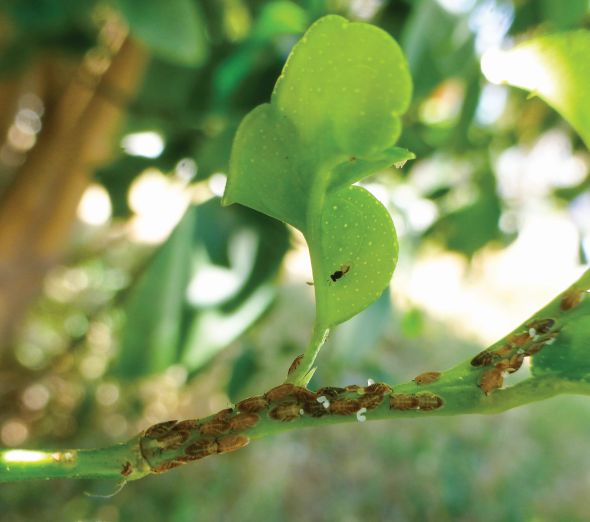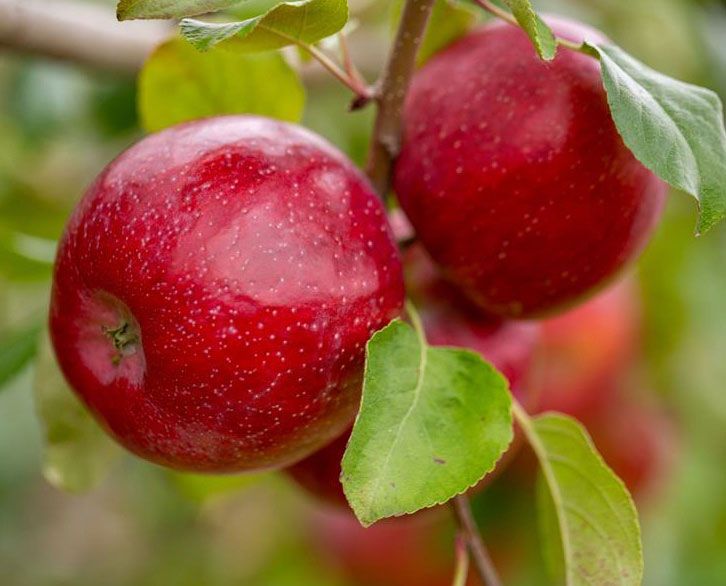Biology Meets Asian Citrus Psyllid Control
The Asian citrus psyllid (ACP) has been found in California for almost 10 years. With the popularity of residential citrus trees, researchers are looking for alternative controls of the pest, along with the prevention of huanglongbing (HLB).
Western Fruit Grower® magazine recently talked with Erica Kistner, a postdoctoral entomology scholar at the University of California, Riverside (UCR) about some of these biological controls.

Erica Kistner
Q: What type of biological controls are being used to control this psyllid?
A: We are currently utilizing two host-specific parasitoids of ACP, Tamarixia radiata and Diaphorencyrtus aligarhensis. These tiny parasitic wasps were sourced from Punjab, Pakistan and are currently being released across California as part of a statewide classical biological control program.
Classical biological control is the deliberate importation and establishment of specialist natural enemies to suppress pest populations to less damaging levels. To date, the California Department of Food and Agriculture has released about 3.4 million individual parasitoids throughout California. Tamarixia and Diaphorncyrtus are not currently commercially available.
Q: Why are biological controls of ACP important for the California citrus industry?
A: Since its accidental introduction in 2008, ACP has become widespread throughout Southern California including San Diego, Imperial, Riverside, Los Angeles, Orange, and San Bernardino counties. These adaptable pests are flourishing in the countless unmanaged residential citrus trees that permeate Southern California’s landscape.
These urban trees provide a safe haven where ACP thrive in the absence of insecticides. If left unchecked, ACP of urban origin may spill over into neighboring citrus groves. This immigration threatens commercial citrus because ACP may acquire the bacterium responsible for huanglongbing (HLB) from infected urban trees and spread it to healthy trees. Keep in mind that all of California’s HLB cases to date have been found solely in urban citrus trees within Los Angeles County. Since widespread chemical control of urban ACP is not economically feasible, biological control is an important ACP management strategy for California’s urban citrus.

A female Tamarixia radiata (top) sits on a citrus leaf, looking at Asian citrus psyllid nymphs suitable for parasitism. (Photo credit: Mike Lewis, CISR, UC-Riverside.)
Q: Can you talk about the two wasps being studied as ACP “specialists?” How were they found/imported? What type of studies are being conducted on them?
A: Specialists are organisms that utilize a very narrow range of resources. Both Tamarixia and Diaphorncyrtus are host-specific parasitoids of ACP, making them both extremely specialized. These insect parasitoids have an immature life stage that develops on or within a single insect host (i.e. ACP), ultimately killing the host. Our parasitoids evolved with ACP in their native range for millions of years, thereby creating a tightly co-evolved system. Given their host specificity, insect parasitoids are commonly utilized as biocontrol agents since they do not attack non-target species.
Mark Hoddle, a Biological Control Extension Specialist at UCR, spearheaded the search for specialist parasitoids of ACP for use in California back in 2010. Pakistan’s Panjub Province was selected for natural enemy collections for two major reasons: 1) it has a 70% climate match with the major citrus production areas of California, and 2) it is part of ACP’s native range. Dr. Hoddle made six collection trips to Pakistan from 2010 to 2013 where he worked with entomologists at the University of Agriculture in Faisalabad.
All ACP natural enemies collected in Pakistan were returned to the Insectary and Quarantine Facility at UCR for safety testing. Only after months of stringent, mandatory safety tests were these parasitoids deemed safe for release in California by USDA’s Animal and Plant Health Inspection Service. Basically, use UC-Riverside entomologists had to prove that our parasitoids do not attack other insects across numerous laboratory studies. After receiving release permits from USDA, we began releasing Tamarixia in December 2011 and Diaphorencyrtus in December 2014.

A female Diaphorencyrtus aligarhensis shown here is one wasp that specifically targets the Asian citrus psyllid. (Photo credit: Mike Lewis, CISR, UC-Riverside.)
Currently, we are monitoring citrus growth, ACP densities, and parasitism rates at selected residential sites. To date, our results indicated ACP densities are strongly linked to seasonal changes in flush growth in conjunction with temperature. While Tamarixia activity is sporadic, parasitism rates often exceeded 50% during periods of peak parasitoid activity and ACP populations have declined at multiple sites since the introduction of Tamarixia.
We are also assessing the short-range dispersal and establishment of Tamarixia from release sites to nearby sites which have not been inoculated with Tamarixia. To date, we have found signs of parasitoid activity at 92 out of 100 sites (24 of which were never inoculated with Tamarixia) across six California counties. These promising results indicate that Tamarixia has successfully established in Southern California’s residential landscape where we hope it will provide cost effective ACP control for many years to come.
The second parasitoid, Diaphorencyrtus, had a much later start than Tamarixia, but after just one year of releases we are already finding signs of Diaphorencyrtus activity at multiple designated release sites. Given that the two parasitoids preferentially attack different immature stages of ACP, it is our hope that they will provide complementary biological control.
Finally, we are examining the impact of naturally occurring predators (e.g. lady beetles) on urban ACP population growth using a combination of predator exclosures and digital video recorders (DVRs) in the field. We found that parasitism by Tamarixia, as well as predation by naturally occurring generalist predators, are helping to limit urban ACP populations.
Q: What should growers know and understand about the research into biological controls? How does this research benefit them?
A: Biological control is an important part of all modern pest management programs. It complements rather than replaces traditional chemical controls methods. For example, ACP management in California employs chemical control in commercial citrus and biological control in urban citrus. By using natural enemies to control urban ACP populations, we hope to reduce ACP numbers and subsequent spread of HLB from infected urban citrus to healthy commercial citrus.
Successful biological control programs can have very long lasting benefits. For instance, the very first biological control program in California was against the cottony cushionscale, a serious pest of citrus that is native to Australia. In 1888-1889 a ladybug, the vedalia beetle, was imported from Australia. This specialist beetle only feeds on cottony cushionscale and it completely controlled this pest within a year of its release in California. The program only cost $3,000 to complete and California has benefited every year since 1889!
For more information on our ACP biological control program please visit the University of California, Riverside, Center for Invasive Species Research blog.










